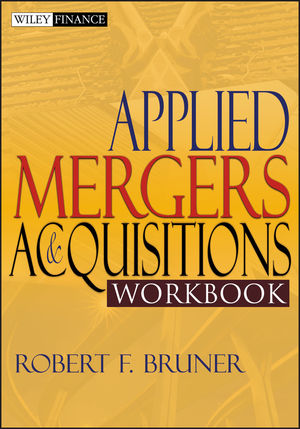Applied Mergers and Acquisitions WorkbookISBN: 978-0-471-39585-0
Paperback
384 pages
March 2004
 Other Available Formats: E-book
|
||||||
PART ONE: QUESTIONS.
Chapter 1: Introduction and Executive Summary.
Chapter 2: Ethics in M&A.
Chapter 3: Does M&A Pay?
Chapter 4: M&A Activity.
Chapter 5: Cross-Border M&A.
Chapter 6: Strategy and the Uses of M&A to Grow or Restructure the Firm.
Chapter 7: Acquisition Search and Deal Origination: Some Guiding Principles.
Chapter 8: Due Diligence.
Chapter 9: Valuing Firms.
Chapter 10: Valuing Options.
Chapter 11: Valuing Synergies.
Chapter 12: Valuing the Firm across Borders.
Chapter 13: Valuing the Highly Levered Firm, Assessing the Highly Levered Transaction.
Chapter 14: Real Options and Their Impact on M&A.
Chapter 15: Valuing Liquidity and Control.
Chapter 16: Financial Accounting for Mergers and Acquisitions.
Chapter 17: Momentum Acquisition Strategies: An Illustration of Why Value Creation Is the Best Financial Criterion.
Chapter 18: An Introduction to Deal Design in M&A.
Chapter 19: Choosing the Form of Acquisitive Reorganization.
Chapter 20: Choosing the Form of Payment and Financing.
Chapter 21: Framework for Structuring the Terms of Exchange: Finding the “Win-Win” Deal.
Chapter 22: Structuring and Valuing Contingent Payments in M&A.
Chapter 23: Risk Management in M&A.
Chapter 24: Social Issues.
Chapter 25: How a Negotiated Deal Takes Shape.
Chapter 26: Governance in M&A: The Board of Directors and Shareholder Voting.
Chapter 27: Rules of the Road: Securities Law, Issuance Process, Disclosure, and Insider Trading.
Chapter 28: Rules of the Road: Antitrust Law.
Chapter 29: Documenting the M&A Deal.
Chapter 30: Negotiating the Deal.
Chapter 31: Auctions in M&A.
Chapter 32: Hostile Takeovers: Preparing a Bid in Light of Competition and Arbitrage.
Chapter 33: Takeover Attack and Defense.
Chapter 34: The Leveraged Restructuring as a Takeover Defense: The Case of American Standard.
Chapter 35: Communicating the Deal: Gaining Mandates, Approval, and Support.
Chapter 36: Framework for Postmerger Integration.
Chapter 37: Corporate Development as a Strategic Capability: The Approach of GE Power Systems.
Chapter 38: M&A “Best Practices”: Some Lessons and Next Steps.
PART TWO: ANSWERS.
Chapter 1: Introduction and Executive Summary.
Chapter 2: Ethics in M&A.
Chapter 3: Does M&A Pay?
Chapter 4: M&A Activity.
Chapter 5: Cross-Border M&A.
Chapter 6: Strategy and the Uses of M&A to Grow or Restructure the Firm.
Chapter 7: Acquisition Search and Deal Origination: Some Guiding Principles.
Chapter 8: Due Diligence.
Chapter 9: Valuing Firms.
Chapter 10: Valuing Options.
Chapter 11: Valuing Synergies.
Chapter 12: Valuing the Firm across Borders.
Chapter 13: Valuing the Highly Levered Firm, Assessing the Highly Levered Transaction.
Chapter 14: Real Options and Their Impact on M&A.
Chapter 15: Valuing Liquidity and Control.
Chapter 16: Financial Accounting for Mergers and Acquisitions.
Chapter 17: Momentum Acquisition Strategies: An Illustration of Why Value Creation Is the Best Financial Criterion.
Chapter 18: An Introduction to Deal Design in M&A.
Chapter 19: Choosing the Form of Acquisitive Reorganization.
Chapter 20: Choosing the Form of Payment and Financing.
Chapter 21: Framework for Structuring the Terms of Exchange: Finding the “Win-Win” Deal.
Chapter 22: Structuring and Valuing Contingent Payments in M&A.
Chapter 23: Risk Management in M&A.
Chapter 24: Social Issues.
Chapter 25: How a Negotiated Deal Takes Shape.
Chapter 26: Governance in M&A: The Board of Directors and Shareholder Voting.
Chapter 27: Rules of the Road: Securities Law, Issuance Process, Disclosure, and Insider Trading.
Chapter 28: Rules of the Road: Antitrust Law.
Chapter 29: Documenting the M&A Deal.
Chapter 30: Negotiating the Deal.
Chapter 31: Auctions in M&A.
Chapter 32: Hostile Takeovers: Preparing a Bid in Light of Competition and Arbitrage.
Chapter 33: Takeover Attack and Defense.
Chapter 34: The Leveraged Restructuring as a Takeover Defense: The Case of American Standard.
Chapter 35: Communicating the Deal: Gaining Mandates, Approval, and Support.
Chapter 36: Framework for Postmerger Integration.
Chapter 37: Corporate Development as a Strategic Capability: The Approach of GE Power Systems.
Chapter 38: M&A “Best Practices”: Some Lessons and Next Steps.



